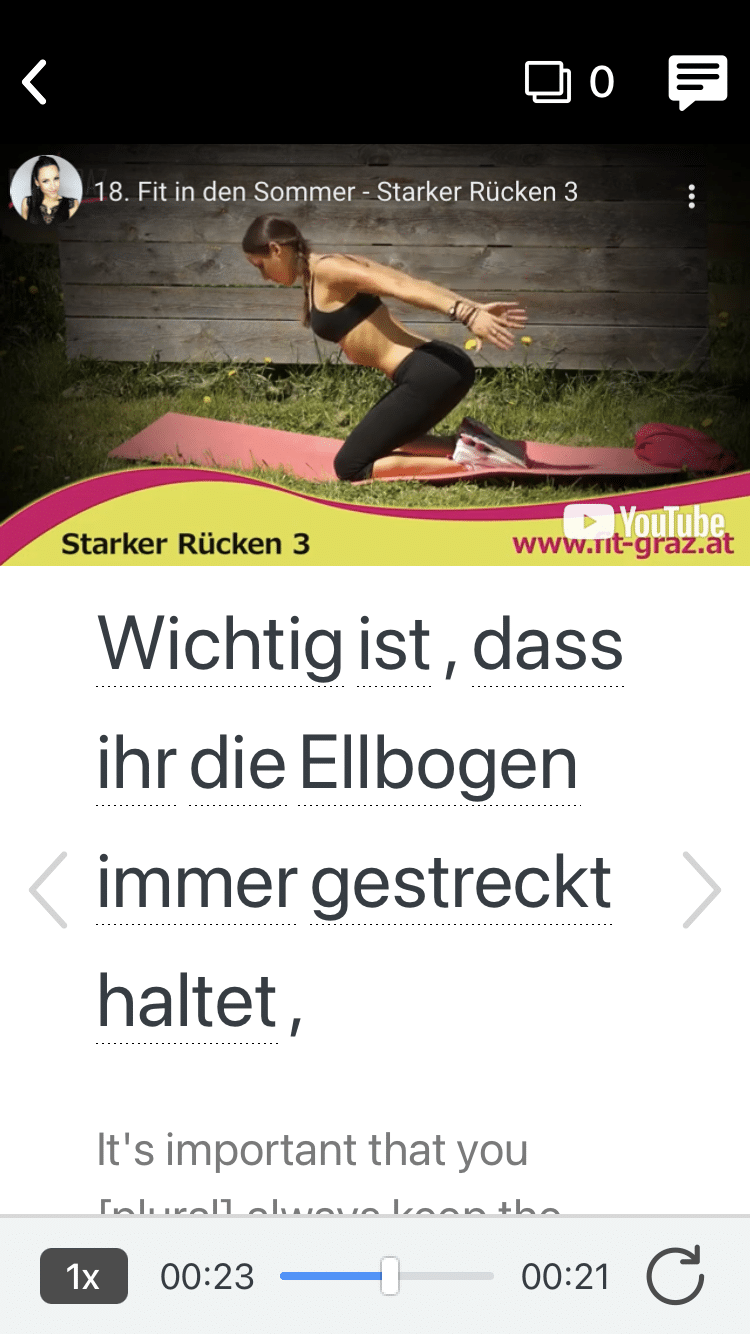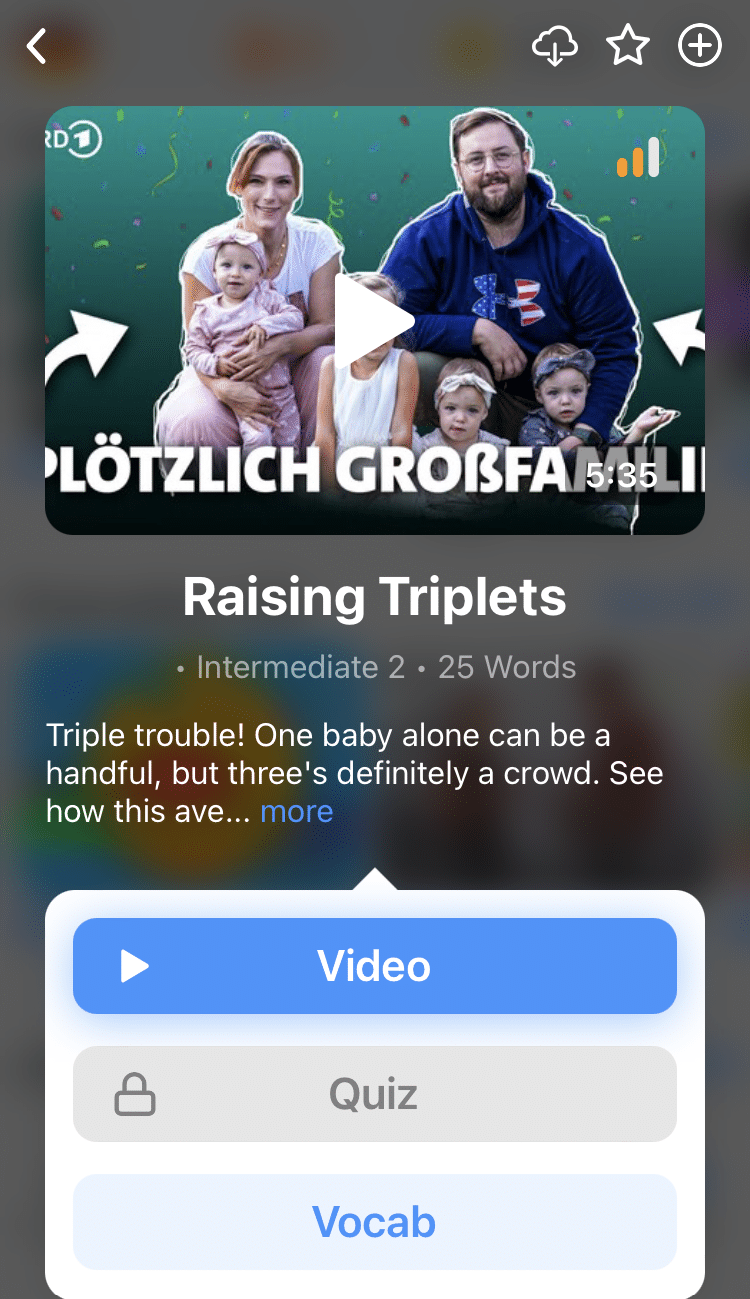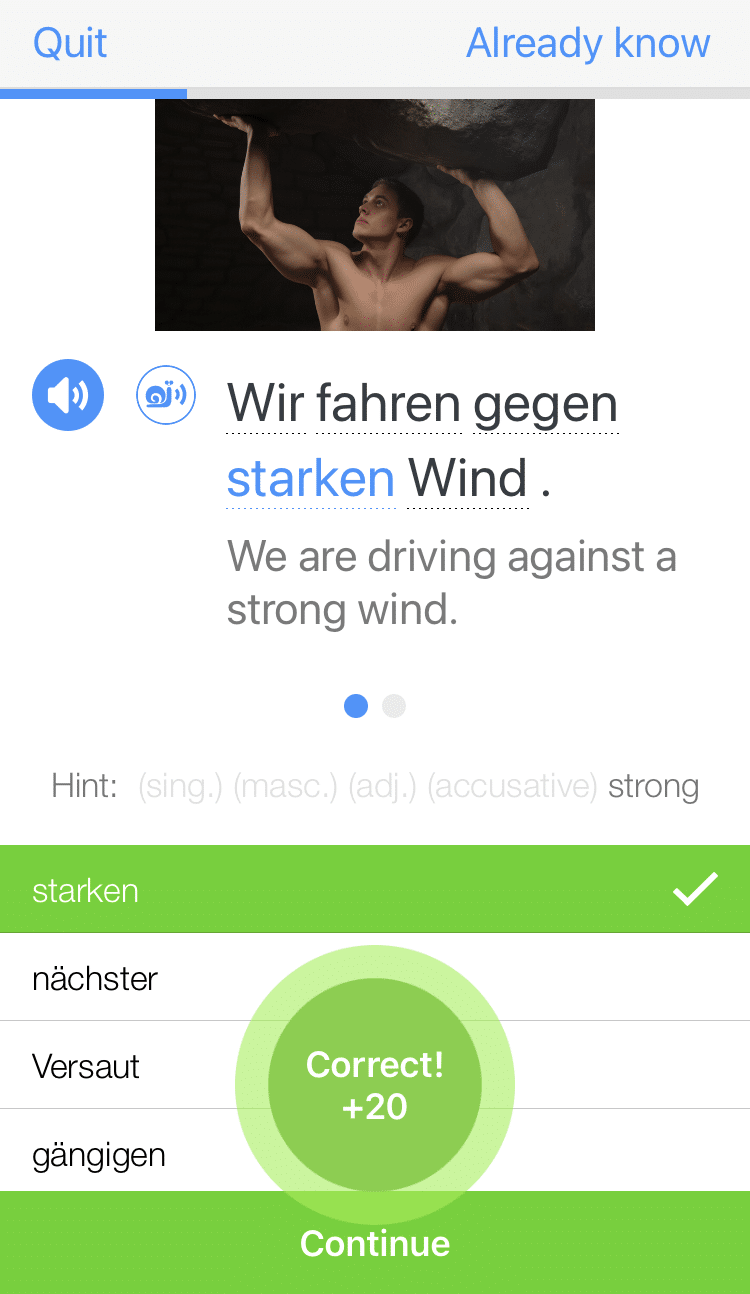
How to Learn German Grammar: 10 Simple and Effective Study Techniques and Tips
When we’re learning German grammar, we want to zip through it so we can get where we’re going: German fluency and the ability to actually communicate with native speakers.
Fortunately for German learners, there are a number of handy tips, tricks and hacks that can help you learn German grammar in a way that’s simpler, faster, more accessible and easier to remember.
Try out these tips and 10 main techniques and you’ll give your German grammar learning progress an instant speed boost.
Contents
- 1. Verb Conjugations: Put Them into Groups
- 2. Irregular Verbs: Put Them in a Verb Book
- 3. German Verb Placement: Remember These Shortcuts
- 4. Separable Verbs: Build on Those Same Shortcuts
- 5. Time Words: Be Flexible with Placement
- 6. Modal Verbs: Don’t Just Learn Meanings, Learn Context
- 7. Grammatical Gender: Group and Label Nouns
- 8. Cases: Focus on the Accusative for Efficiency
- 9. The Conditional Tense: Just Add Umlaut!
- 10. It’s Okay to Cheat… Sometimes
- More Tips to Learn German Grammar
- And One More Thing...
Download: This blog post is available as a convenient and portable PDF that you can take anywhere. Click here to get a copy. (Download)
1. Verb Conjugations: Put Them into Groups
Here’s how to learn German grammar the hard way: memorize an entire conjugation table for all the forms of every single new verb you encounter.
Sound awful? Yeah.
Here’s how to learn German grammar the fast and easy way: put verb conjugation rules into groups that you can apply to many different verbs.
We’ll get you started with some common verb groupings that German learners can use.
Regular Verbs
For regular verbs (where the stem doesn’t change in different verb forms) such as trinken (to drink), machen (to do/make) and suchen (to search), follow these simple instructions:
Take the infinitive and subtract the –en. You’re left with the stem. Then add the appropriate ending to the stem:
- Ich (I): -e
- Du (informal you): -st
- Ihr (you all) and er, sie, es (he, she, it): -t
The conjugations for Sie (you formal), wir (we) and sie (they) remain the same as the infinitive, and this rule holds true for all verbs in German—regular and irregular.
Let’s implement this rule on the conjugation of the verb machen (to do), as an example.
The infinitive is machen, and the stem is mach, so you get the following conjugations:
ich mache
du machst
er/sie/es macht
ihr macht
wir/Sie/sie machen
Stem-changing Verbs
Next, we have verbs whose stems change in different forms. It gets easier to remember such verbs by categorizing them even further into three main groups:
- Stem change e to ie. Eg: lesen (to read): ich lese, du liest, er/sie/es liest, ihr lest, wir/Sie/sie lesen
- Stem change a to ä. Eg: fahren (to drive): ich fahre, du fährst, er/sie/es fährt, ihr fahrt, wir/Sie/sie fahren
- Stem change e to i. Eg: geben (to give): ich gebe, du gibst, er/sie/es gibt, ihr gebt, wir/Sie/sie geben
You might have noticed that the verb conjugation rules are pretty similar to regular verbs. The only change is that there’s a stem change in the du and er/sie/es forms.
Haben and Sein
Two of the most important verbs in German are haben (to have) and sein (to be). The conjugations for these verbs have to be learned by heart.
One easy way to do so is to take a die made of either cardboard or wood and label all the pronouns: ich, du, er, sie, es... (I, you, he, she, it). Then, roll the die and state the correct conjugation for whichever pronoun appears. This trick works for verbs where the conjugations simply have to be memorized (more on those just below).
Check out this post to learn the basics in German verb conjugation:
German Verb Conjugation: How to Talk About the Past, Present and Future | FluentU German Blog
Learn German verb conjugation with this complete guide to conjugating verbs in the past, present and future. Take a closer look at verb types like regular (weak),…
2. Irregular Verbs: Put Them in a Verb Book
As you’re probably aware, there are tons of irregular verbs in German. Annoyingly, this means that there’s a long list of verbs that you need to individually learn by heart as they don’t fit the usual patterns of conjugation.
One of the easiest ways to work your way through the verbs is to add them to a verb book. You can quickly make one out of a journal or notepad.
Make four columns on each page: One for the English translation, one for the present tense, one for the past tense and one for the future tense. There are of course other tenses that you could add, such as the conditional, but if you’re a beginner these four columns should be enough for now. Research the conjugations with your grammar book or on your favorite conjugation app.
It’s important that you return to this verb book often to review each word and to try and drum the conjugation into your head. Constantly reviewing them can really help them stick, especially if you speak them out loud! Not only that, but you’ll also see that there are in fact some patterns to irregular verbs—see if you can spot them when you list your verbs.
For more on irregular verbs in German, see this post:
German Irregular Verbs: 5 Tips to Conjugate Them Like a Pro | FluentU German Blog
German irregular verbs can make you want to pull your hair out when you first encounter them. As soon as you get them down pat, though, you’ll sound and write like a…
3. German Verb Placement: Remember These Shortcuts
The verb positions in German are quite rigidly placed depending on the type of sentence you have. These shortcuts will help you get the word order right whenever you construct a sentence in German:
- In W Fragen (W Questions), the verb comes second, after the question word.
Woher kommen Sie? (Where do you come from?)
- In statements, the verb again comes in the second position (after the subject).
Ich komme aus Deutschland. (I come from Germany.)
- In yes/no questions (Ja/Nein Fragen) the verb comes first.
Kommen Sie aus Deutschland? (Do you come from Germany?)
- A comma splitting up two clauses usually makes the following verb go to the end. In German, you need to split up clauses with a comma, but that isn’t always necessary in English. You always need to notice these commas as they’re like signposts—they tell you that the following verb needs to go to the end of the sentence.
Ich habe eine Pizza gegessen, weil ich Hunger hatte. (I ate a pizza because I was hungry.)
One useful tip that I’ve personally used to memorize word order is to box, circle, underline or write the verbs in different colors in the sentence. This helps create a mental image that makes you feel as though something is wrong whenever you misplace the verb and prompts you to place it correctly.
For more on German verb and word placement and overall sentence structure, check out this post:
German Sentence Structure: The Ultimate Guide to German Word Order | FluentU German Blog
Tackle German sentence structure with this complete guide to proper German word order. Go beyond simple SVO sentences to discover the rules of TeKaMoLo and learn when to…
4. Separable Verbs: Build on Those Same Shortcuts
Separable verbs are very much a unique feature of the German language and there are more than 12,000 of these. It’s important to understand the syntax of separable verbs and how they’re used as well as where to place them in a sentence.
Every separable verb is comprised of a verb and a prefix. The verb part is like the main tool, and the prefix is like an accessory. I can change these prefixes/accessories to form new meanings. Thus, it makes sense to list these verbs according to the verb stems, in order to remember their meanings well.
If you consider the verb stem fahren, there’s a series of separable verbs building off of it:
abfahren: to depart—which breaks into fahren and ab (prefix)
losfahren: to drive away—which breaks into fahren and los (prefix)
zurückfahren: to drive back—which breaks into fahren and zurück (prefix)
In this manner, one can create word lists or trees with different verb stems of separable verbs and improve German vocabulary!
Now that we’ve got that out of the way, let’s start building on the word order shortcuts we discussed above.
When a separable verb is used alone in a sentence or a question (as in, the separable verb is the only verb in the statement or question) the prefix is positioned at the end. Let’s take a look at an example.
Anrufen (to call someone on the telephone) splits into rufen (the verb part) and an (the prefix).
Statement: Ich rufe meine Mutter an. (I call my mother.)
Yes/No Question: Rufst du meine Mutter an? (Are you calling my mother?)
W Question: Wann rufst du meine Mutter an? (When are you calling my mother?)
As you can see, the verb part is either placed in the first or second position, as usual, depending on whether it’s a yes/no question, a W question or a statement and conjugated according to the subject pronoun.
To go into more depth with German separable verbs, see this post:
German Separable Verbs: United They Stand, Divided They… Also Stand! | FluentU German Blog
German separable verbs can trip you up, but there are some tricks to learning them. Read this post to learn what they are, how to know if a prefix or verb is separable,…
5. Time Words: Be Flexible with Placement
Exceptionally, time in German sentences can begin a statement (not questions though) or be placed anywhere.
Look at the following examples:
Heute gehe ich in die Bäckerei. (Today, I’m going to the bakery.)
Ich gehe am Wochenende ins Kino. (I go to the cinema on the weekend.)
To learn more about time words in German, see this post:
Essential German Time Words and Phrases to Tell the Time with Ease | FluentU German Blog
Learn how to tell the time in German with some basic German time words, phrases and expressions! Read this guide to see common words to know, and how to use them. Plus,…
6. Modal Verbs: Don’t Just Learn Meanings, Learn Context
The big five modal verbs in German are können (can), müssen (must), dürfen (may), sollen (should) and wollen (want). These are whole modal verbs, as a second main verb is required along with these verbs.
The partial modal verbs are möchten and mögen. They’re partial modal verbs as they don’t require a second verb.
You know the words. Now, how do you use them?
First and foremost, it’s important to associate the context with modal verbs. You can use each modal verb only in a certain context:
- können is used to express ability/talent
- müssen is used to express forced conditions
- dürfen is used to express permission in legal and personal situations
- sollen is used to express advice
- wollen is used to express a strong desire
- möchten is the equivalent of “would like” and is used to politely ask for something like a coffee or an order
- mögen is used to express general likes and dislikes
Next, the conjugations for each of these verbs need to be learned. One can use the technique with the dice again.
Modal verbs are neither regular nor irregular, they’re just a separate set of verbs that work differently. They’re mainly used as helping/auxiliary verbs.
In modal verbs, the ich and the er/sie/es conjugations are the same, which makes them a tad easier to remember.
After memorizing the conjugations, one final thing you’ll need to learn is the positioning of the words in a sentence.
In statements and W questions, the modal verb comes in the second position (after the question word or the subject), whereas in yes/no questions, it comes in the first position, conjugated according to the subject pronoun. The second verb comes at the end in the infinitive form.
This makes more sense when you see it in use:
Wann kannst du morgen kommen? (When can you come tomorrow?)
Ich soll viel Wasser trinken. (I should drink a lot of water.)
Darf ich hier parken? (May I park here?)
Again, the boxing or circling technique would help with remembering the verb positions.
Learn more about German modal verbs here:
6 German Modal Verbs You Need to Know and How to Use Them | FluentU German Blog
German modal verbs let you describe what you like, express a desire or even ask to go to the bathroom. Check out our post on the six modal verbs in German: dürfen (may),…
7. Grammatical Gender: Group and Label Nouns
The biggest monster in the German language is getting the articles and genders right. Often there’s no logic as to why a particular noun is masculine, feminine or neuter. For example, why is a chair masculine, but a bag is feminine and a mobile phone is neuter? No answer!
Here are some useful tips to create some method in the madness.
Group Similar Objects by Type, Then Learn by Exception
For example, if we were to group all electronic gadgets in German, most of the objects are masculine. The exceptions are the mobile phone and the radio, which are neutral and the telephone, which is feminine.
If you group all beverages instead, you discover that hot beverages such as tea and coffee are masculine, strong beverages such as wine, vodka and champagne are masculine, juices are masculine and mild drinks such as water and beer are neutral.
Surround Yourself with Grammatical Gender Labels
Labeling is another useful technique. Take out a bunch of sticky notes, write the German word for an object with the correct article and stick it on that object in your house. Looking at this object every day with a sticky note on it embeds the article and gender in your brain.
For example, write down Der Tisch and stick it on the table, Der Stuhl on the chair, Die Tasche on the bag and so on.
German possessive articles are equally important, so you can put those on your labels, too. (Plus, if you share a bit of your German knowledge, these notes can warn your siblings or roommates to stay away from your stuff!)
Use possessive articles correctly with the help of the following questions:
- Who possesses the object? If it’s me, use mein-. If it’s you, use dein– or Ihr– and so on.
- What’s the gender of the possessed object? If it’s feminine or plural, add an e at the end of the possessive article, i.e. mein would become meine, dein would become deine and so on.
To dive in deeper to German gender, check out this handy post:
The Ultimate Guide to Der, Die and Das | FluentU German Blog
“Der,” “die” and “das” can confuse any language learner, but with some helpful tricks you can master these German articles for “the.” Click here to learn how to nail them…
8. Cases: Focus on the Accusative for Efficiency
Each case in German refers to a different use of nouns, and depending on the case of nouns in sentences, it can change the definite and indefinite articles. A change in case can also have an effect on adjective endings.
The easiest one to learn is the nominative as it’s the only one we use in English, and it doesn’t affect any articles or adjective endings. The next easiest one to learn is the accusative.
It’s important that you get as familiar as possible with the accusative as, after the nominative, it’s the most-used case in German. Learning this case well will make your German studies a lot more efficient, especially in the very early stages.
Plus, once you’re skilled at using the accusative in German, you’ll find that it helps to reinforce the dative and genitive as you move on to learn them. That’s because you’ll already be used to changing articles and adjective endings according to certain situations.
In other words, changing articles and adjective endings according to the dative and genitive cases—which is often viewed as being much harder than the accusative case—won’t come as such a shock to you.
Taking one of these accusative quizzes will help you bring your knowledge up to speed in no time at all!
For more on the German case system, read this explanation post:
German Cases Explained, Plus Memorization Tips and Practice Resources | FluentU German Blog
Confused about German cases? Think you’ve got them down but want to make sure? You’re in the right place! In this post we’ve got all four German cases explained, some tips…
9. The Conditional Tense: Just Add Umlaut!
If you’re ever unsure how to form the conditional tense of a verb, remember you just need to add an umlaut to the preterite form of the verb.
You can see that in action in this list:
war — wäre
was — would be
musste — müsste
had to — would have to
hatte — hätte
had — would have
This is a very solid rule of thumb, so if you ever need to guess the conditional form of a verb, it’s a safe guess to simply stick an umlaut on the first vowel.
Go here for more information on the German conditional tense:
German Conditional Tense: The Ins and Outs of This Cool Grammar Pattern | FluentU German Blog
The German conditional tense allows talk about your colorful fantasies in German—or any other hypothetical situation, really. Find out what makes up this wonderful…
10. It’s Okay to Cheat… Sometimes
Even native German speakers don’t get their own grammar right 100% of the time, and it’s not like anyone bats an eyelash at them. That’s because there are rarely situations or scenarios that call for absolutely perfect grammar. Most people are very relaxed with their use of language, which is shown by everyone’s use of slang.
This is something you should use to your advantage as you’re learning German grammar. You don’t have to be too hard on yourself if you forget a grammar rule or word while you’re speaking, and you shouldn’t let this harm your confidence.
You’ll also find that you naturally pick up clues from what the other person is saying, and the language they use might even help you remember some key grammar points. So, don’t let your inexperience get in the way of your confidence—just keep talking and see what comes to you!
If you’re a native English speaker, cheating is even easier and more effective. Many aspects of English and German grammar are very similar to one another, so this is definitely something that you should use to your advantage.
For example, when you start to learn German, you’ll see that quite a bit of basic word order follows the same patterns as in English. To see this work, take a look at these sentences:
Ich trinke Tee. (I drink tea.)
Ich habe Tee getrunken. (I have drunk tea.)
The only big difference is in that second German sentence where the past participle is at the end of the clause.
Another way in which German and English are very similar is in their verbs. Quite a few German verbs look just like their English translations, such as the following:
singen (to sing)
tanzen (to dance)
stinken (to stink)
The whole point of this is to show you that you can steal ideas from English if you’re ever stuck with an aspect of German grammar. If you’re midway through a conversation or writing something and you aren’t sure of the German translation for a verb, you could just try and Germanize the English word.
You can do that by adding “-en” as in the above examples. And if it’s sentence order that you’re confused about, you could stick to the English rules and you have a good chance of being right.
To dive deeper into the world of German slang and other useful vocabulary, check out these posts:
149 German Slang Words and Phrases Your Textbook Isn’t Teaching You (With Audio and Examples) | FluentU German Blog
Looking for the latest German slang? Look no further. In this post, we share 149 German slang words and expressions that you might not find in your textbook. Words like…
100 Most Common German Words: Your Ultimate Vocabulary List | FluentU German Blog
Learning the 100 most common German words is a great way to quickly and effectively boost your comprehension and communication skills. Check out these 100 frequently used…
More Tips to Learn German Grammar
German grammar isn’t the easiest as any beginner German language learner will tell you. The German language has a somewhat complex case system and words are divided up into three genders.
Because of this, you should follow these tips to make the grammar journey as painless as possible:
- Consistent Practice
Consistency in learning German grammar is crucial for several reasons. Firstly, it helps establish a strong foundation, allowing learners to build upon their knowledge progressively. Secondly, it reinforces correct usage patterns, making it easier to internalize grammatical rules and apply them accurately in both writing and speech. Additionally, consistent practice fosters fluency, reducing the likelihood of making common errors. - Use Authentic Materials
Incorporating authentic materials into the process of learning German grammar is paramount for a comprehensive understanding of the language. Authentic materials, such as native texts, videos and audio recordings, expose learners to real-life usage and contextual nuances.This exposure not only enhances comprehension but also familiarizes learners with colloquial expressions and cultural references. Additionally, it promotes a more natural and intuitive grasp of grammar, as learners witness how rules are applied in authentic everyday situations.
- Language Apps
Using language apps for learning German grammar provides a structured and interactive approach that’s easy to stick with. These apps offer curated lessons, exercises and quizzes that target specific grammar concepts, ensuring a systematic progression in learning.To make it more fun, they often incorporate multimedia elements, including audio and visual aids. The gamification aspect of these apps makes the learning process engaging and motivating, encouraging consistent practice. Additionally, many apps offer instant feedback, allowing learners to correct mistakes and reinforce correct usage.
- Cultural Immersion
Cultural immersion is a powerful tool in learning German grammar as it provides a real-world context for language usage. By surrounding oneself with native speakers and their cultural practices, you gain exposure to natural language patterns and colloquial expressions.This firsthand experience helps solidify grammar rules, showing how they’re applied in everyday conversations, written materials and cultural events.
Hopefully, all of these tips, tricks and methods for how to learn German grammar will make it all much easier!
Download: This blog post is available as a convenient and portable PDF that you can take anywhere. Click here to get a copy. (Download)
And One More Thing...
Want to know the key to learning German effectively?
It's using the right content and tools, like FluentU has to offer! Browse hundreds of videos, take endless quizzes and master the German language faster than you've ever imagine!
Watching a fun video, but having trouble understanding it? FluentU brings native videos within reach with interactive subtitles.
You can tap on any word to look it up instantly. Every definition has examples that have been written to help you understand how the word is used. If you see an interesting word you don't know, you can add it to a vocabulary list.
And FluentU isn't just for watching videos. It's a complete platform for learning. It's designed to effectively teach you all the vocabulary from any video. Swipe left or right to see more examples of the word you're on.
The best part is that FluentU keeps track of the vocabulary that you're learning, and gives you extra practice with difficult words. It'll even remind you when it’s time to review what you’ve learned.
Start using the FluentU website on your computer or tablet or, better yet, download the FluentU app from the iTunes or Google Play store. Click here to take advantage of our current sale! (Expires at the end of this month.)






